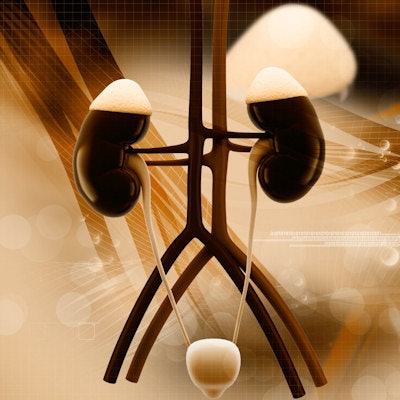
The overall usage rate of emergency CT for patients with suspected urinary stones has doubled over the past decade, with marked variations based on patient demographics, type of insurance, and hospital location, according to an article published online June 17 in the Journal of the American College of Radiology.
The group, led by first author Dr. Patricia Balthazar from Emory University School of Medicine, examined trends in the utilization of noncontrast abdominal and pelvic CT for urolithiasis in the U.S. Nationwide Emergency Department Sample databases of 2006 through 2015. The team's analysis covered more than 11 million emergency department cases for suspected urolithiasis during this period.
In recent years, a number of studies have shown that clinicians' use of CT in hospital emergency departments has been increasing at an exponential rate. The American College of Emergency Physicians and various governmental bodies have enacted multiple initiatives to dampen this growth but only to minimal effect, the authors noted.
From 2006 to 2014, Balthazar and colleagues found that the total number of urolithiasis cases assessed in hospital emergency departments rose by 17.9%. Even after accounting for this increase in urolithiasis presentation, the usage rate of CT for those visits increased by 100.8%, with a compound annual growth rate of 8%.
(The researchers did not include the data from 2015 in their analysis since the data were incomplete, although figures from the first three quarters of the year indicated an even steeper increase in the CT usage rate.)
| Trends in emergency CT usage rate for suspicion of urinary stones | ||
| 2006 | 2014 | |
| Emergency department visits for urolithiasis | 1,057,119 | 1,246,041 |
| Proportion of patients who underwent CT for urolithiasis | 24.6% | 49.4% |
Furthermore, multivariable analyses revealed that the use of CT for suspected urolithiasis was highly variable and much more common for patients who matched certain socioeconomic, demographic, and geographic factors.
| Likelihood of undergoing an emergency CT exam for urolithiasis | |
| Patient factors | Odds ratio |
| Evaluated at a hospital in the U.S. Northeast (compared with the Midwest) | 5.07 |
| Lived in a ZIP code with the highest relative household income | 1.48 |
| Evaluated at an urban hospital | 1.42 |
| Had private payor insurance | 1.22 |
| Evaluated at a nonteaching hospital | 1.20 |
| Male sex | 1.13 |
"The disparities in CT utilization on the basis of socioeconomic factors as shown herein, such as by payor type and household income, raise concerns about the overutilization of imaging resources, potentially inappropriate radiation exposure, and limitations in patient access to care," the authors wrote.
Collectively, these findings confirm the continuing rise in emergency CT use despite the work of several governmental and organizational initiatives, they concluded. The information may prove valuable to clinicians, researchers, and policymakers seeking to optimize the use of CT and other medical imaging modalities in hospital emergency departments.



















